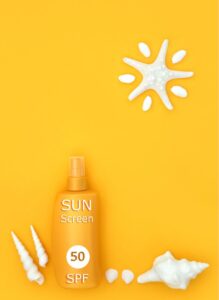Spring Skincare: Time For A Change

Skincare is not a routine that is set in stone. Depending on the season, readjustments and adjustments are necessary. After all, we change the tires on our car after the frosty months and swap a T-shirt for a turtleneck. It all goes without saying. No discussion. But what about our skin?
Skincare should adapt to the season. With the change from winter to spring, the skin is exposed to less cold and dry air, but higher humidity and more sun. While we used to pamper it with layers of rich creams, serums and oils during the cold season, now more lightness is required.
You may now be saying that the jar of expensive winter cream is still half full. I can’t just throw it out now. You should at least do that when applying it to your face. If we continue to stick to our winter rituals, the skin will literally get short of breath under the thick layers of skin care when the outside temperatures warm up and the humidity rises.
“The oily products would clog the pores and lead to heat build-up. This causes redness and, in the worst case, inflammation,” says Dr. Timm Golüke, dermatologist in Munich. Nevertheless, winter cream doesn’t have to go in the bin. My tip: I use it on my décolleté and also on my shins, which are prone to dryness. Luxury, I know. But before the product sits open in the jar until next winter and is then unusable…
Skincare in spring: UV protection SPF50
In spring, it is best to replace the richer moisturizer or oil-based serum with a hyaluronic acid, water or aloe vera-based texture. Now the skin can store more moisture on its own and needs less support in this respect. And such a light serum still has all the nutrients the cells need. It is also absorbed more quickly, which is an advantage during the day.
In addition, New York dermatologist Dermatologin Dr. Patricia Wexler strongly advises a high light filter: “While a moisturizer with SPF 30 is sufficient in winter, it should be at least SPF 50 now, apart from lotion and make-up.” Dermatologists have long agreed that, regardless of the weather and temperature, all parts of the body that are exposed to light need UV protection – on a daily basis. Unfortunately, the reality is different.
Especially people who live in northern regions or have rarely spent the winter outdoors tend to forget sun protection in spring. So buy a new bottle now – and not in the summer – and start using it as soon as you go outside.
The spring sun is all too often underestimated and the risk of sun damage is much higher than in summer, when you expect it. When it comes to filter systems, there is a well-known distinction between chemical and physical filters with titanium or zinc oxide. “Chemical filters are good for preventing skin cancer, but they are not the best choice against photoaging. Physical filters, on the other hand, meet both requirements,” says the American dermatophatologist Dr. Adarsh Vijay Mudgil.
More glow: Exfoliation does the trick
The second tip in the Glow Game, as Dr. Wexler calls it, is called exfoliation. “Contrary to popular belief, we need to exfoliate the skin when it is particularly dry,” explains Wexler. To remove dead skin cells and open up clogged pores, gently exfoliating cleansers are a better choice than aggressive scrubbing treatments, which are more likely to cause irritation.
Cleansers are particularly effective if they contain a small amount of glycolic acid. However, you should not overdo it. Over-exfoliating makes the skin more sensitive to the sun and causes sunburn more quickly. A combination of exfoliation and mask is better. “A moisturizing mask once a week also helps against dry flakes and ‘repairs’ the winter complexion,” recommends Dr. Golüke.
Some things from the bathroom have to go
You should also spring clean your beauty tool box. After a good six months, cleansing brushes, sponges and brushes must always be replaced. Such old products can harbor bacteria that lead to clogged pores and a dull complexion. Make-up brushes in particular, whether with natural or synthetic hair, are a breeding ground for germs. If they are dirty, this can have unexpected effects on the general health of the skin. Therefore, wash them at least once a week with liquid soap, gently squeeze them out with a paper towel and dry them in the air or with a hairdryer.
Incorrect skincare?
Switching from winter to summer skincare is good for the skin. But the temptation to try out one of the new, promising products more often is great. State-of-the-art technologies, innovative ingredients and luxurious textures are all too seductively advertised by the industry. Constantly giving in to them can have fatal consequences for the skin. Although skincare products work immediately, they need to be used regularly for at least six weeks to reach their full potential. This is particularly true for the three most important substances in anti-ageing management, whose effect has also been clinically proven. Vitamin C, retinol and SPF are designed for long-term results if you want to noticeably improve the appearance of your skin.
It is legitimate and even necessary to rethink or change your skincare routine if the purging phase should be over but your skin is still rebelling. Purging is the term used to describe the effect when a new skincare product causes blemishes. This is normal at first because the skin often gets worse before it gets better. However, if it doesn’t stop and irritation and redness continue to appear, you have “purging”. In this case, the product may not be suitable for your skin type. One reason may be that the pH value does not suit the skin. To find a more suitable product, it is best to talk to your dermatologist or beautician.
Hautpflege, skincare, sping change

CultureAndCream Author from Munich
To travel during my profession as a beauty journalist was never enough for my. Also my six month on a world trip didn’t do it. It always attracts me to other cities, foreign countries, on roadtrips and places I don’t know yet. But I am not only interested in “culture” and “cream”, I am also fascinated by people who have stories to tell . Such unique experiences I want to share with you.






